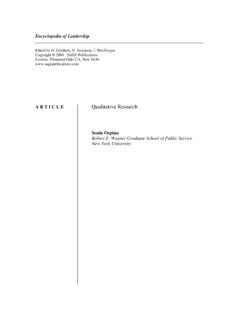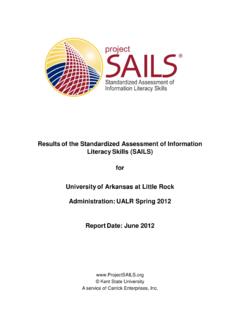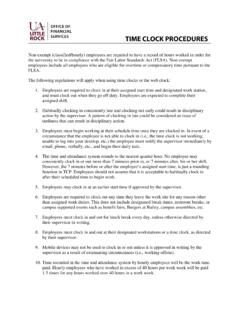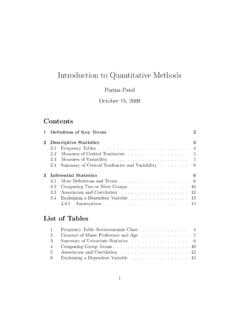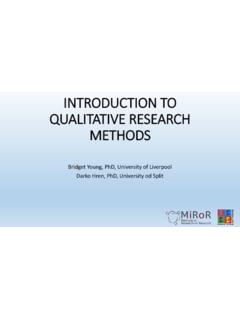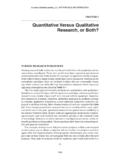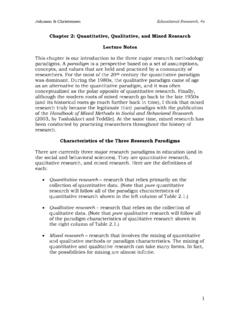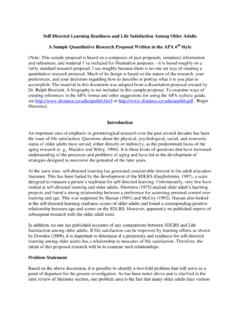Transcription of A R T I C L E Qualitative Research Sonia Ospina Robert F ...
1 Encyclopedia of Leadership _____. Edited by G. Goethals, G. Sorenson, J. MacGregor Copyright 2004 SAGE Publications London, Thousand Oaks CA, New Delhi ARTICLE Qualitative Research Sonia Ospina Robert F. Wagner Graduate School of Public Service New York University Qualitative Research . Leadership scholars seeking to answer questions about culture and meaning have found experimental and quantitative methods to be insufficient on their own in explaining the phenomenon they wish to study. As a result, Qualitative Research has gained momentum as a mode of inquiry. This trend has roots in the development of the New Leadership School, (Conger, 1999; Hunt, 1999), on the recent emergence of an approach to leadership that views it as a relational phenomenon (Fletcher, 2002), and on the increased recognition of the strengths of Qualitative inquiry generally. Shank (2002) defines Qualitative Research as a form of systematic empirical inquiry into meaning (p.)
2 5). By systematic he means planned, ordered and public , following rules agreed upon by members of the Qualitative Research community. By empirical, he means that this type of inquiry is grounded in the world of experience. Inquiry into meaning says researchers try to understand how others make sense of their experience. Denzin and Lincoln (2000) claim that Qualitative Research involves an interpretive and naturalistic approach: This means that Qualitative researchers study things in their natural settings, attempting to make sense of, or to interpret, phenomena in terms of the meanings people bring to them (p. 3). The advantages of doing Qualitative Research on leadership include (Conger, 1998;. Bryman et al, 1988; Alvesson, 1996): flexibility to follow unexpected ideas during Research and explore processes effectively;. sensitivity to contextual factors;. ability to study symbolic dimensions and social meaning.
3 Increased opportunities o to develop empirically supported new ideas and theories;. o for in-depth and longitudinal explorations of leadership phenomena; and o for more relevance and interest for practitioners. THE CONTRIBUTION OF Qualitative DESIGNS. Transformational leadership scholars attend to the management of meaning as an important dimension of leadership (Cal s and Smircich, 1991;Yukl, 1994, 1999; Meindl, et al 1986). Neo-charismatic scholars view charisma as a social phenomenon that requires in-depth examination of context and actors over time. Conger (1998) argues that quantitative Research alone can not produce a good understanding of leadership, given the extreme and enduring complexity of the leadership phenomenon itself (p. 108). Leadership involves multiple levels of phenomena, possesses a dynamic character and has a symbolic component, elements better addressed with Qualitative methodologies, he argues.
4 Likewise, favoring grounded theory, Parry (1998) claims that quantitative methods are insufficient to theorize successfully about the nature of leadership, understood as a social influence process. The high sensitivity of leadership to context is well established in the literature. quantitative researchers incorporate contextual variables in their models but conceptualize them abstractly ( task structure' or position power'), obscuring the impact of context-specific forces. Qualitative researchers are well positioned to open this black box'. Qualitative studies about circumstances associated with organizational types or occupational settings have provided new insights into the dynamics of leadership (Bryman et al, 1996). Some New Leadership scholars have also used a mixed approach to understand contextual variables such as culture. For example, in their international Research program, House and his associates use both methods to study leadership in 170.
5 Countries (House et al, 1999). Others argue for process-focused studies to better understand the hows and whys of transformational and charismatic leadership (Bass, 1995; Lowe and Gardner, 2001). Bryman (1986) identifies two forms of Qualitative Research in the New Leadership literature. One distills lessons from portraits of successful leaders to illustrate particular ideas. The other, more academic', explore several Research designs: case studies using participant observation, semi-structured interviewing and document analysis; multiple case study design, adding comparative analysis; and interview studies asking leaders about their practices and orientations, or inviting individuals to discuss other leaders or leadership practices (Bryman et al, 1996). Other Qualitative designs found in the literature include ethnography, narrative inquiry, action Research and grounded theory (Tierney, 1996; Schall et al, 2002; Huxham and Vangen, 2000; Parry, 1998).
6 Contemporary emergent approaches view leadership as a meaning making process in communities of practice (Drath, 2001) or as a set of functions and relationships distributed rather than concentrated around a single individual (Pearse and Conger, 2002). These new theoretical lenses call for Qualitative designs. For example, Gronn's (1999) study of a famous mountain school campus in Australia explored the relational dynamics between two leaders credited for this school's success. Analyzing correspondence, school council records, alumni files, archival material and newspapers, he shifted the unit of analysis away from methodological individualism to consider collective forms of leadership. THE NATURE OF Qualitative Research . While quantitative and Qualitative inquiry represent two legitimate ways to investigate leadership, researchers using one or the other tackle empirical Research differently.
7 Everet and Louis (1981) clarify the assumptions that ground each by distinguishing two Research stances: inquiry from the outside , often implemented via quantitative studies and inquiry from the inside via Qualitative studies. These approaches differ in the degree of the researcher's immersion in terms of experiential engagement, direct contact with the subjects, and physical involvement in the setting. In the inside or Qualitative approach, the researcher aims for a holistic picture from historically unique situations, where idiosyncrasies are important for meaning. The researcher uses an inductive mode, letting the data speak. In contrast, traditional outside or quantitative researchers aim to isolate the phenomenon, to reduce the level of complexity in the analysis and to test hypotheses derived previously. Shank uses two metaphors to differentiate these ways of seeing' in Research .
8 One metaphor is the window', to look through to get an accurate view of a subject. Microscopes are windows that help to do inquiry from the outside. The researcher tries to correct for smudges (to avoid bias) or to clarify in what ways the window is flawed (to identify error). This image corresponds to mainstream leadership Research , and requires simplification and standardization of complex observations. In contrast to the window, the lantern' metaphor helps shed light in dark corners (Shank, ). This image characterizes Qualitative researchers as discoverers and reconcilers of meaning where no meaning has been clearly understood before (Shank p. 11). The approaches to inquiry described with the window, inquiry from the outside, and by extension, quantitative Research , are best known as logical positivism and post-positivism. The lantern, inquiry from the inside and Qualitative Research , represent an approach known as interpretivism (Crotty, 1998; Denzin and Lincoln, 2000).
9 Historically, the strong hold of quantitative methodologies in leadership studies can be explained by the dominance of the fields of social psychology and organizational behavior which have been highly influenced by positivism (House and Adytay, 1996; Parry, 1998; Podsakoff, 1994). A VARIETY OF INTERPRETIVE COMMUNITIES. All Qualitative researchers aspire to illuminate social meaning. However, some use Qualitative methods exclusively, others to complement or better interpret numerical data, and others to generate hypotheses for future quantitative studies (See Box 1). Various choices and practices fall along a continuum, where some researchers are closer to positivism and others distance radically from it. Between the poles there is a spectrum of Qualitative traditions that stand on their own. Different traditions represent different interpretive communities' (Denzin and Lincoln, 2000).
10 Close to positivism, post-positivists accept the limits of positivism, talk about probability rather than certainty and consider the limits of objectivity (Crotty, 1998). For them, Qualitative Research becomes an important complement to quantitative methods when these fall short. In the opposite side of the continuum is post-modernism, seeking to replace positivism with inquiry stances that capture multiple voices and perspectives in local contexts. Post-modernists assume that theories only provide partial views of their objects, and that every representation of the world is filtered through history and language, so it can not be neutral (Best and Kellner, 1991). In contrast to the realism of post-positivists, post-modernists explore how language, power and history shape human views of reality, truth and knowledge, aiming to uncover multiple realities. Post- modernists favor critical methods that are intrinsically Qualitative (Hollinger, 1994, p.)
